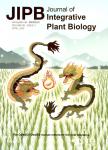Differentiation of a Miniature Inverted Transposable Element (MITE) System in Asian Rice Cultivars and Its Inference for a Diphyletic Origin of Two Subspecies of Asian Cultivated Rice
Differentiation of a Miniature Inverted Transposable Element (MITE) System in Asian Rice Cultivars and Its Inference for a Diphyletic Origin of Two Subspecies of Asian Cultivated Rice作者机构:National Center for Gene Research Shanghai Institutes of Biological Sciences the Chinese Academy of Sciences Shanghai 200233 China Graduate School of the Chinese Academy of Sciences Beijing 100039 China Zhejiang Academy of Agricultural Sciences Hangzhou 310021 China
出 版 物:《Journal of Integrative Plant Biology》 (植物学报(英文版))
年 卷 期:2006年第48卷第3期
页 面:260-267页
核心收录:
基 金:Supported by Grants from the Ministry of Science and Technology of China (2002AA2Z1003 and 2003AA222091 ) Shanghai Municipal Commission of Science and Technology (038019315) and the National Natural Science Foundation of China (30325014)
主 题:diphyletic indica japonica Miniature Inverted Transposable Element (MITE) mPing rice.
摘 要:In the present study, we report a survey on a Miniature Inverted Transposable Element (MITE) system known as mPing in 102 varieties of Asian cultivated rice (Oryza sativa L.). We found that mPing populations could be generalized Into two families, mPing-1 and mPing-2, according to their sequence structures. Further analysis showed that these two families of mPing had significant bias in their distribution pattern in two subspecies of rice, namely O. sativa ssp. japonica and indica. 0. sativa japonica has a higher proportion of mPing-1 as a general trait, whereas 0. sativa indica has a higher proportion of roPing-2. We also examined the mPing system In a doubled haploid (DH) cross-breeding population of jingxi 17 (japonica) and zhaiyeqing 8 (indica) varieties and observed that the mPing system was not tightly linked to major subspecies-determining genes. Furthermore, we checked the mPing system in 28 accessions of Asian common wild rice O. rufipogon and found the roPing system in 0. rufipogon. The distribution pattern of the roPing system in O. rufipogon indicated a diphyletlc origin of the Asian cultivated rice O. sativa species. We did not find the mPing system in another 20 Oryza species. These results substantiated a previous hypothesis that O. ruflpogon and O. nivara species were the closest relatives of O. sativa and that the two extant subspecies of O. sativa were evolved independently from corresponding ecotypes of O. ruflpogon.



